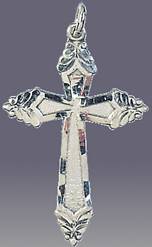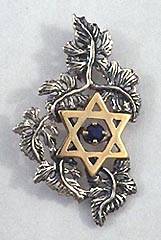Charms and Amulets
Description: A critical examination of the use of charms and amulets prevalent in the past and present societies and the general Islamic ruling regarding them.
By Imam Mufti
Published on 15 Dec 2011 - Last modified on 25 Jun 2019
Printed: 1,112 - Emailed: 1 - Viewed: 43,839 (daily average: 10)
Prerequisites
·Belief in Allah (2 parts).
Objectives
·To understanding how prevalent charms and amulets are in modern society.
·To learn the precise meaning of a charm, amulet, and talisman.
·To become generally familiar with common amulets.
·To become familiar with charms and amulets in pre-Islamic Arabia.
·To learn the general Islamic ruling on charms and amulets.
·To know the Islamic ruling on Quranic charms and amulets.
Arabic Terms
·Shirk – a word that implies ascribing partners to Allah, or ascribing divine attributes to other than Allah, or believing that the source of power, harm and blessings comes from another besides Allah.
·Ruqyah – spells.
For thousands of years people have tried to bring good luck and avert bad luck from them and their property by employing charms, amulets, and talismans. A charm is a practice or expression believed to have magic power, similar to an incantation or a spell.[1] A talisman is an object bearing a sign or engraved character, and thought to act as a charm to avert evil and bring good fortune.[2] Amulets were used to protect man, or his possessions, such as houses and cattle from the evil influences of witches, demons, and other mischievous powers, or to counteract misfortune and illness. The amulet is found both in the Orient and in the West, among tribes and nations down to the present day. Assyrians and Egyptians, Greeks and Romans, Jews and Christians, fostered this ancient superstition, and, in varying degrees, foster it today.[3] Despite technical and scientific advancements, superstitions and amulets continue to pervade the Western society. Some of the amulets popular in the West are:
(1) A horseshoe. The most commonly encountered lucky charm in modern North America is the horseshoe and its representative models in the form of jewelry, wall hangings, and printed images. The use of worn-out horseshoes as magically protective amulets - especially hung above or next to doorways - originated in Europe, where one can still find them nailed onto houses, barns, and stables from Italy through Germany and up into Britain and Scandinavia.
(2) The four-leaf clover. The four-leaf clover is among the commonest of North American lucky emblems and is an especially frequent image on good luck coins, and good luck postcards.
(3) The wishbone or “merry thought.” The wishbone is the third most popular American amulet, next only to the horseshoe and the four-leaf clover. It is a bone overlying the breastbone of fowl, as in a chicken, or turkey. It is the custom to save this bone intact when carving the bird at dinner and to dry it over the stove or by the fire until it is brittle. Once dry, it is given to two people, who pull it apart until it cracks, each one making a wish while doing so. The person who gets the “long half” of the wishbone will have his or her wish “come true.” If the wishbone breaks evenly, both parties get their wishes.
(4) The Rabbit’s Foot.
(5) Charm bracelets.
(6) Good Luck coins or ‘pocket pieces.’
(7) The Lucky or Smiling Buddha commonly found in Oriental shops and restaurants.

The Crucifix. When blessed, it is considered an important sacramental.

Hebrew Amulets: Grape-Leaf Star of David pendant. One of its ancient uses was as a magical Kabalistic symbol.
Charms & Amulets in Pre-Islamic Arabia
Arabian amulets (tameemah in Arabic) are made from pearls or bones that are worn on the necks of children or adults, or are hung up in houses or cars, in order to ward off evil – especially the evil eye – or to bring some benefits. The Arabs in the time of Prophet Muhammad, may the mercy and blessings of Allah be upon him, used to wear arm bracelets, bangles, beaded necklaces, shells, and similar amulets to bring good luck or avert bad fortune.
Islamic Ruling on Amulets
Allah is the sole Lord and Ruler of the physical world. ‘Lord’ means He is the Creator and controls all affairs in the universe; the Kingdom of the heaven and the earth belongs exclusively to Him, and He owns them. He alone brought existence out of non-existence and it depends on Him for its conservation and continuance. His power is required at every moment to sustain all creatures. Angels, prophets, human beings, and the animal and plant kingdoms are under His control. Only Allah knows what the future holds. Good luck and bad fortune are from Allah alone.
Faith in charms, amulets, and talismans contradict belief in Allah’s Lordship by attributing the ability to bring good luck or avert bad fortune to these created brings whereas only Allah can bring good and avert harm. Consequently, the Prophet, may the mercy and blessings of Allah be upon him, opposed these superstitious practices and taught people to have firm belief in their Lord, rather than amulets, which cannot change what Allah has destined and can bring no good fortune to anyone. Even though they are not capable of averting any harm, belief in amulets usually leads to idolatry over time. This can be seen among Catholics where the crucifix, statues, and medallions of saints are worn or kept for blessings and good fortune.
When people accepted Islam in the time of the Prophet, they carried with them their old faith in amulets. The Prophet strictly forbade them to adhere to such:
(1) The Messenger of Allah, may the mercy and blessings of Allah be upon him, said,
‘Spells (ruqyah), amulets and love-charms are shirk.” (Ahmad, Abu Dawud)
(2) The Messenger of Allah said,
“Whoever wears an amulet, may Allah not fulfill his need, and whoever wears a sea-shell, may Allah not give him peace.” (Ahmad)
(3) A group came to the Messenger of Allah to pledge their allegiance to him. He accepted the allegiance of nine of them. They said, “O Messenger of Allah, you accepted the allegiance of nine but not of this one.” The Prophet said,
“He is wearing an amulet.”
The man put his hand in his shirt and took it off, then the Prophet accepted his allegiance, saying,
‘Whoever wears an amulet has committed shirk.” (Ahmad)
The companions strictly abided by the prohibition set by the Prophet on amulets. They openly opposed such practices even among their family members. For example, Hudhayfah, one of the companions of the Prophet, visited a sick man, and seeing a bracelet on the man’s upper arm, he pulled it off and broke it, then recited the verse,
“Most of them who believe in Allah, commit shirk.” (Quran 12:106)[4]
On another occasion he touched the upper arm of a sick man and found a cord bracelet tied to it. The man told Hudhayfah that it contained a spell specially made for him, so Hudhayfah tore if off and said, ‘If you had died with it on, I would never have prayed over your funeral.’[5]
Once, ibn Mas’ood said, “I heard the Messenger of Allah say,
‘Spells (ruqyah), amulets and love-charms are shirk.”
Zaynab, the wife of ibn Mas’ud said, “Why do you say this? By Allah, my eye used to discharge and I kept going to so and so, the Jew, who put a spell on it (indicating a charm necklace) for me, and it (the eye) calmed down.” Ibn Mas’ud snatched it from her neck and broke it. ‘Surely, the family of Abdullah has no need for shirk,” he uttered… “That was just the work of the devil who was picking it with his hand, and when (the Jew) uttered the spell, he stopped. All you needed to do was to say as the Messenger of Allah used to say:
‘Adhhib il-ba’s Rabb al-naas ishfi anta al-Shaafi laa shifaa’a illa shifaa’uka shifaa’an laa yughaadiru saqaman
“Remove the harm, O Lord of mankind, and heal, You are the Healer. There is no healing but Your healing, a healing which leaves no disease behind.” (Abu Daud, Ibn Majah)
Wearing an amulet is shirk because, instead of relying upon Allah, the heart becomes attached to the amulet, trusting that it will bring good luck and love, or avert bad fortune or disease.
Islamic Ruling on Quranic Charms & Amulets
Some Muslims wear the Quran as a good luck charm either by hanging it in their car, or on key chains, or wearing it on bracelets or necklaces. A miniature Quran is worn in lockets. ‘Allah,’ ‘Bismillah,’ ‘La ilaha ill-Allah,’ or specific verses of the Quran, sometimes written in small illegible script, are worn as pendants or lockets are also used. Wearing them for decoration is obviously not shirk, but most people wear them for protection or blessings. Therefore, this practice of wearing the Quran as a good luck charm should be discouraged for the following reasons:
(i) It may lead to wearing non-Quranic amulets that are considered shirk by common people who cannot distinguish between the two.
(ii) It is disrespectful to wear the Name or Word of Allah in the toilet and it is not always possible for a person wearing Quranic amulets to remove them every time she visits the toilet.
(iii) The Prophet himself did not wear such amulets or put them on his family members for protection or blessings, instead he cautioned against all forms of amulets.
Footnotes:
[1] “charm.” Encyclopædia Britannica from Encyclopædia Britannica Premium Service. (http://www.britannica.com/eb/article-9125164)
[2] “talisman.” Encyclopædia Britannica from Encyclopædia Britannica Premium Service. (http://www.britannica.com/eb/article-9071049)
[3] Jewish Encyclopedia, p. 546.
[4] Ibn Abi Hatim
[5] Ibn Waki’
Previous Lesson: Omens
- Beginners Guide to the Quran (part 1 of 3)
- Beginners Guide to the Quran (part 2of 3)
- Beginners Guide to the Quran (part 3 of 3)
- Beginners Guide to Hadith & Sunnah
- The Importance of Prayer
- Pre-requisites of Prayer
- Hygiene in Islam
- Bathing (Ghusl)
- Ablution (Wudoo)
- Performing Two Units of Prayer
- Performing Three Units of Prayer
- Performing Four Units of Prayer
- General Points About Prayer
- A Day in the life of a Muslim (part 1 of 2): From Waking uptill late Morning
- A day in the life of a Muslim (part 2 of 2): From Noon to Bed
- Fate of Non-Muslims
- Repentance (part 1 of 3): Door to Salvation
- Repentance (part 2 of 3): Conditions of Repentance
- Repentance (part 3 of 3): Prayers of Repentance
- Can We See Allah?
- Preservation of Sunnah (part 1 of 4)
- Preservation of Sunnah (part 2 of 4)
- Preservation of Sunnah (part 3 of 4)
- Preservation of Sunnah (part 4 of 4)
- Eating – The Islamic Way (part 1 of 2)
- Eating – The Islamic Way (part 2 of 2)
- Simple Explanation of Quran’s Greatest Verse: Aaya tul-Kursi
- Wiping Over Socks, Making Up Prayers, and Prayer of a Traveler
- Omens
- Charms and Amulets


